暑期英语提升(七升八)八年级上- 情态动词考点精讲
文档属性
| 名称 | 暑期英语提升(七升八)八年级上- 情态动词考点精讲 | 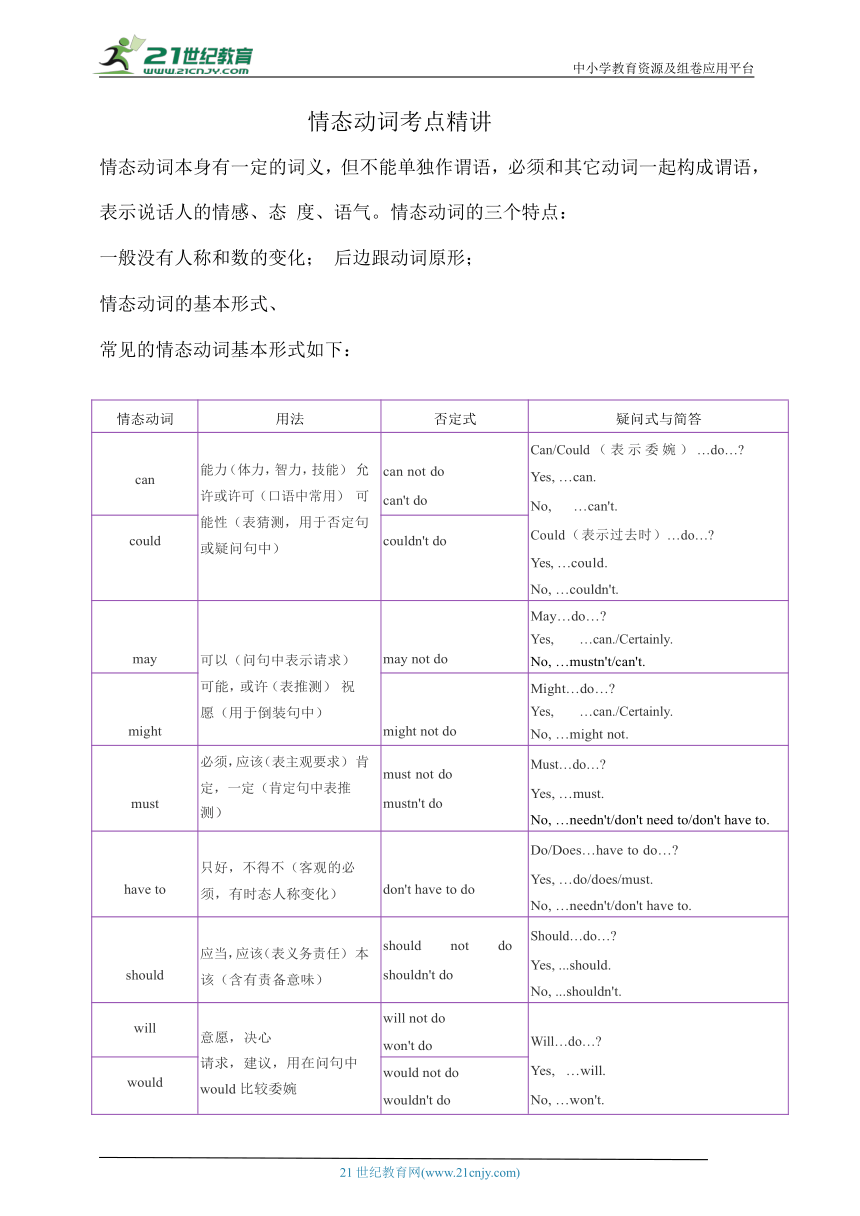 | |
| 格式 | zip | ||
| 文件大小 | 1.2MB | ||
| 资源类型 | 试卷 | ||
| 版本资源 | 人教新目标(Go for it)版 | ||
| 科目 | 英语 | ||
| 更新时间 | 2022-07-19 23:36:02 | ||
图片预览

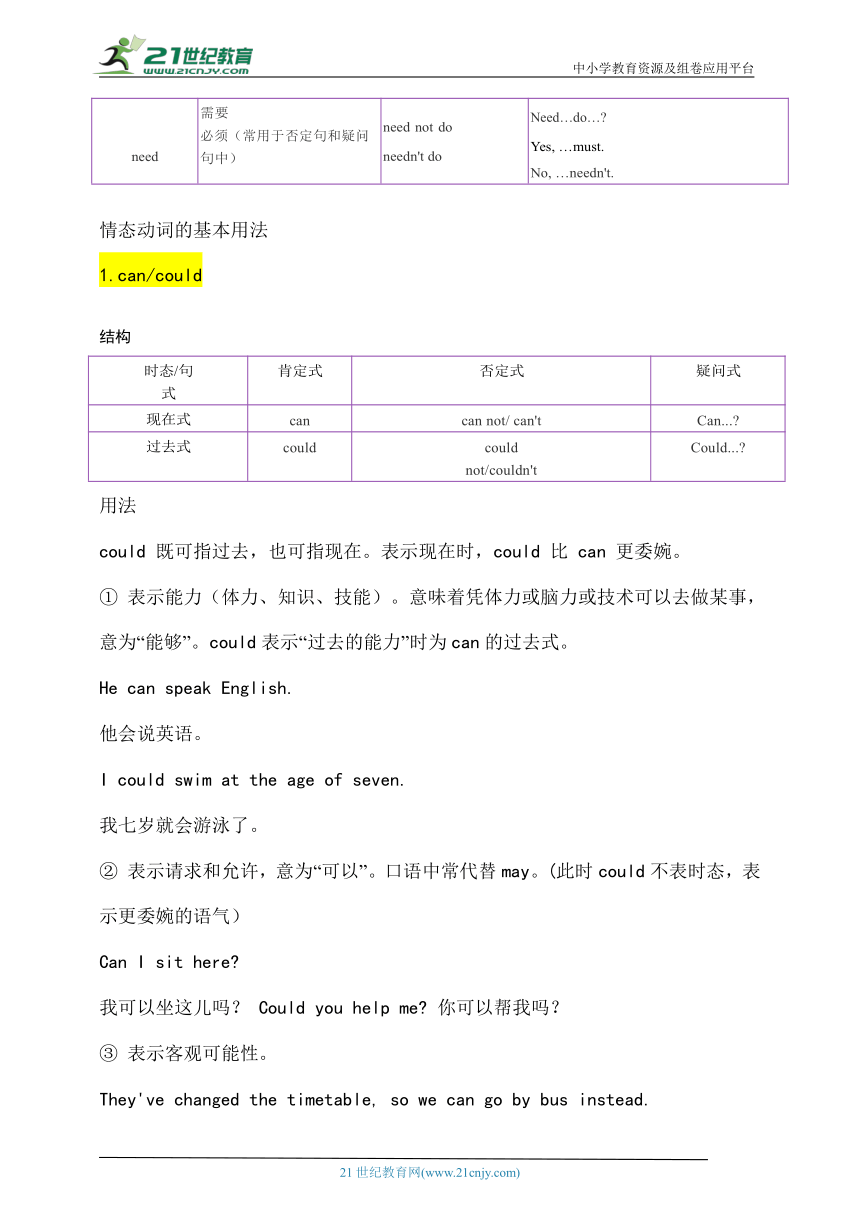
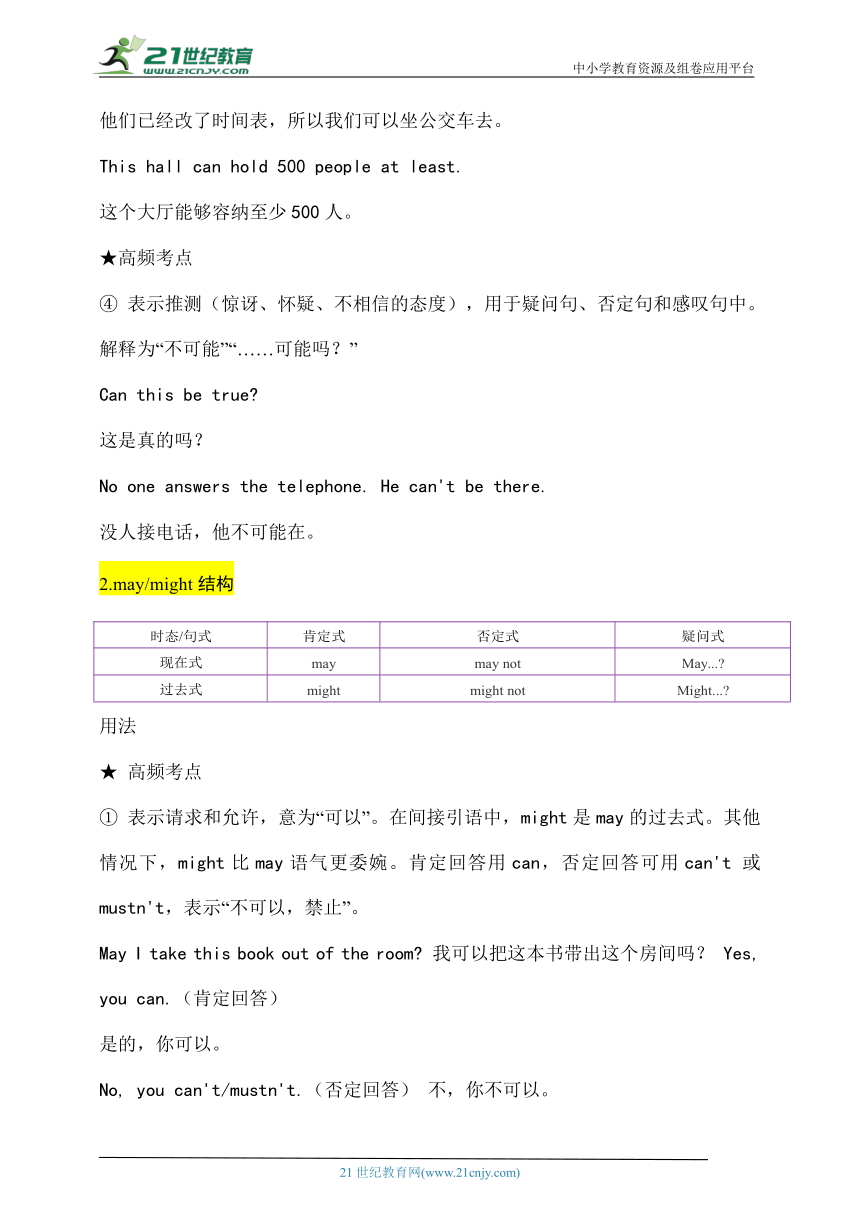
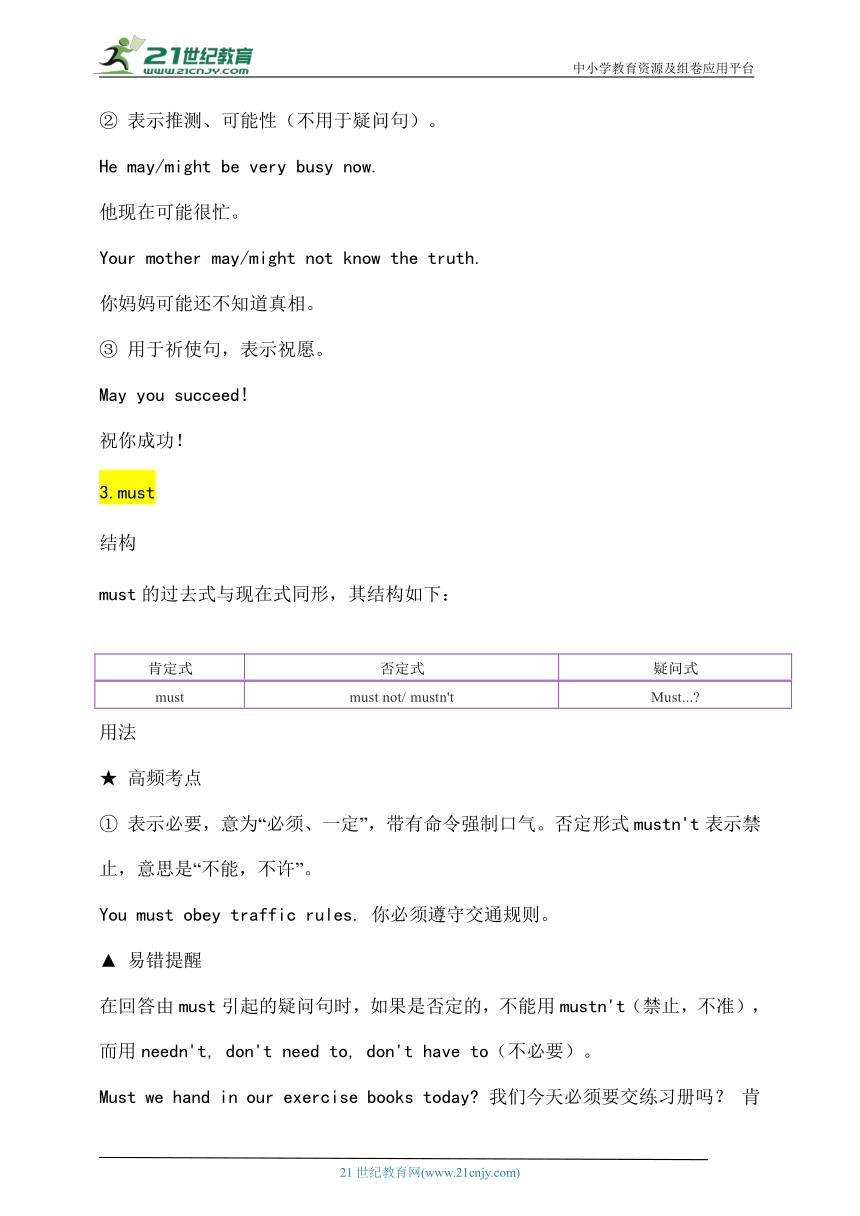
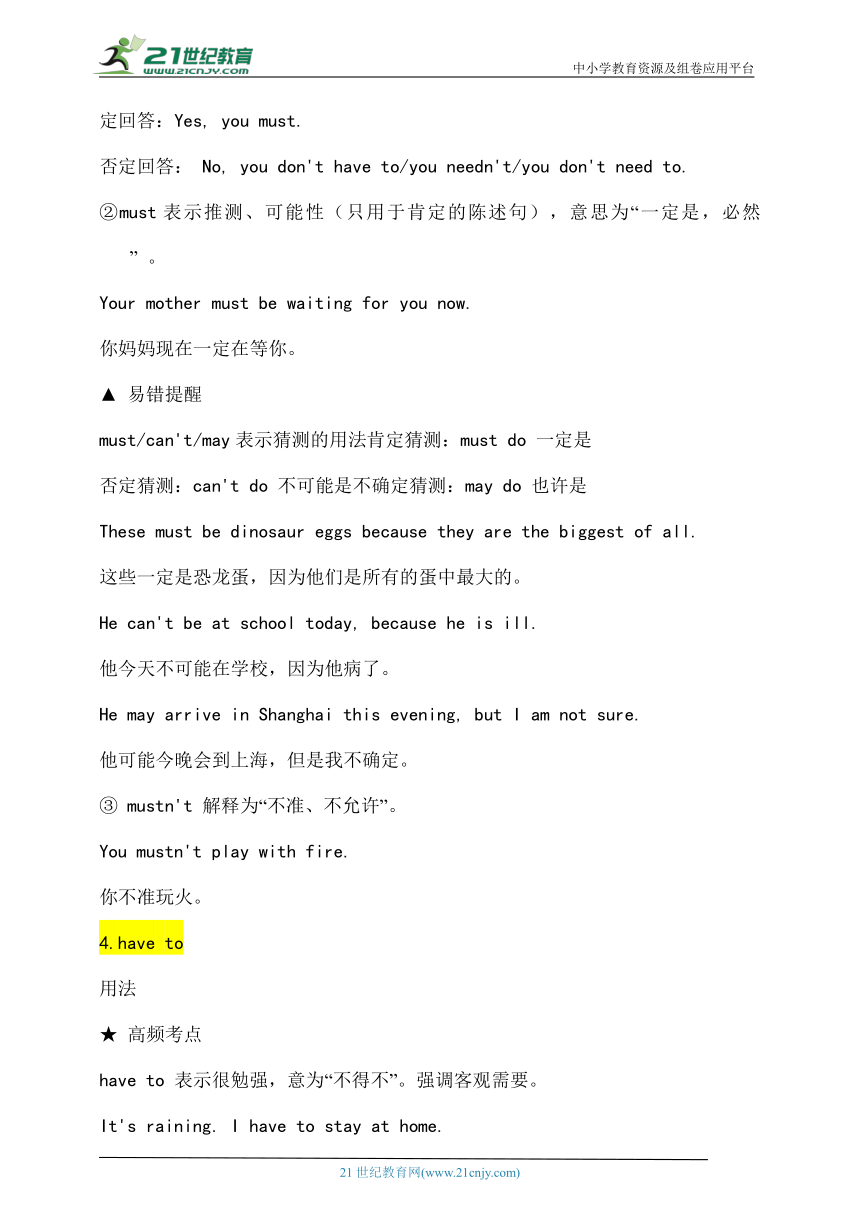
文档简介
中小学教育资源及组卷应用平台
情态动词考点精讲
情态动词本身有一定的词义,但不能单独作谓语,必须和其它动词一起构成谓语,表示说话人的情感、态 度、语气。情态动词的三个特点:
一般没有人称和数的变化; 后边跟动词原形;
情态动词的基本形式、
常见的情态动词基本形式如下:
情态动词 用法 否定式 疑问式与简答
can 能力(体力,智力,技能) 允许或许可(口语中常用) 可能性(表猜测,用于否定句或疑问句中) can not do can't do Can/Could(表示委婉)…do… Yes, …can.No, …can't. Could(表示过去时)…do… Yes, …could.No, …couldn't.
could couldn't do
may 可以(问句中表示请求) 可能,或许(表推测) 祝愿(用于倒装句中) may not do May…do… Yes, …can./Certainly. No, …mustn't/can't.
might might not do Might…do… Yes, …can./Certainly. No, …might not.
must 必须,应该(表主观要求) 肯定,一定(肯定句中表推测) must not do mustn't do Must…do… Yes, …must.No, …needn't/don't need to/don't have to.
have to 只好,不得不(客观的必须,有时态人称变化) don't have to do Do/Does…have to do… Yes, …do/does/must.No, …needn't/don't have to.
should 应当,应该(表义务责任) 本该(含有责备意味) should not do shouldn't do Should…do… Yes, ...should.No, ...shouldn't.
will 意愿,决心请求,建议,用在问句中would比较委婉 will not dowon't do Will…do… Yes, …will. No, …won't.
would would not dowouldn't do
need 需要必须(常用于否定句和疑问句中) need not do needn't do Need…do… Yes, …must.No, …needn't.
情态动词的基本用法
1.can/could
结构
时态/句式 肯定式 否定式 疑问式
现在式 can can not/ can't Can...
过去式 could could not/couldn't Could...
用法
could 既可指过去,也可指现在。表示现在时,could 比 can 更委婉。
① 表示能力(体力、知识、技能)。意味着凭体力或脑力或技术可以去做某事,意为“能够”。could表示“过去的能力”时为can的过去式。
He can speak English.
他会说英语。
I could swim at the age of seven.
我七岁就会游泳了。
② 表示请求和允许,意为“可以”。口语中常代替may。(此时could不表时态,表示更委婉的语气)
Can I sit here
我可以坐这儿吗? Could you help me 你可以帮我吗?
③ 表示客观可能性。
They've changed the timetable, so we can go by bus instead.
他们已经改了时间表,所以我们可以坐公交车去。
This hall can hold 500 people at least.
这个大厅能够容纳至少500人。
★高频考点
④ 表示推测(惊讶、怀疑、不相信的态度),用于疑问句、否定句和感叹句中。解释为“不可能”“……可能吗?”
Can this be true
这是真的吗?
No one answers the telephone. He can't be there.
没人接电话,他不可能在。
2.may/might结构
时态/句式 肯定式 否定式 疑问式
现在式 may may not May...
过去式 might might not Might...
用法
★ 高频考点
① 表示请求和允许,意为“可以”。在间接引语中,might是may的过去式。其他情况下,might比may语气更委婉。肯定回答用can,否定回答可用can't 或mustn't,表示“不可以,禁止”。
May I take this book out of the room 我可以把这本书带出这个房间吗? Yes, you can.(肯定回答)
是的,你可以。
No, you can't/mustn't.(否定回答) 不,你不可以。
② 表示推测、可能性(不用于疑问句)。
He may/might be very busy now.
他现在可能很忙。
Your mother may/might not know the truth.
你妈妈可能还不知道真相。
③ 用于祈使句,表示祝愿。
May you succeed!
祝你成功!
3.must
结构
must的过去式与现在式同形,其结构如下:
肯定式 否定式 疑问式
must must not/ mustn't Must...
用法
★ 高频考点
① 表示必要,意为“必须、一定”,带有命令强制口气。否定形式mustn't表示禁止,意思是“不能,不许”。
You must obey traffic rules. 你必须遵守交通规则。
▲ 易错提醒
在回答由must引起的疑问句时,如果是否定的,不能用mustn't(禁止,不准),而用needn't, don't need to, don't have to(不必要)。
Must we hand in our exercise books today 我们今天必须要交练习册吗? 肯定回答:Yes, you must.
否定回答: No, you don't have to/you needn't/you don't need to.
②must表示推测、可能性(只用于肯定的陈述句),意思为“一定是,必然 ” 。
Your mother must be waiting for you now.
你妈妈现在一定在等你。
▲ 易错提醒
must/can't/may表示猜测的用法肯定猜测:must do 一定是
否定猜测:can't do 不可能是不确定猜测:may do 也许是
These must be dinosaur eggs because they are the biggest of all.
这些一定是恐龙蛋,因为他们是所有的蛋中最大的。
He can't be at school today, because he is ill.
他今天不可能在学校,因为他病了。
He may arrive in Shanghai this evening, but I am not sure.
他可能今晚会到上海,但是我不确定。
③ mustn't 解释为“不准、不允许”。
You mustn't play with fire.
你不准玩火。
4.have to
用法
★ 高频考点
have to 表示很勉强,意为“不得不”。强调客观需要。
It's raining. I have to stay at home.
外面正在下雨。我不得不待在家里。
▲ 易错提醒
must 是说话人的主观看法,且must无其他形式
have to 则强调客观需要,且have to有人称,数,时态变化。肯定形式:have to / has to / had to
否定形式:don't / doesn't / didn't + have to The movie is boring. I really must go now. 电影很无聊,我真的得走了。
I had to work when I was at your age.
当我像你这个年龄的时候,我不得不工作。
5.should
should的结构
肯定式 否定式 疑问式
should should not/ shouldn't Should...
should的用法
① 表示义务、责任、劝告、建议,意为“应该”。
You should clean your room.
你应该打扫一下你的房间。
She shouldn't play computer games.
她不应该玩电脑游戏。
② 表示期待,意为“按道理说应该”。
It is seven o'clock. The film should begin soon.
七点了,电影要开始了。
6.will/would
结构
时态/句式 肯定式 否定式 疑问式
现在式 will will not/ won't Will...
过去式 would would not/wouldn't Would...
用法
① 表示请求、建议等,would更委婉(常用语第二人称)。
Will/ Would you pass me the ball, please 能请你把球传给我一下吗?
Would you like some juice 你想要一些果汁吗?
② 表示意志、愿望和决心(用于各种人称)。
I will never do that again. 我永远不会那样做。
They asked him if he would go abroad. 他们问他是否会出国。
③ would表示过去反复发生的动作或某种倾向。During the vacation, he would visit me every other day. 假期期间,他每隔两天就会来看我一次。
7.need
结构
need既可以作情态动词又可以作实义动词,意为“需要”。
need做情态动词时的结构
肯定式 否定式 疑问式
need need not/ needn't Need...
用法
★ 高频考点
① need 作情态动词用时, 常用于疑问句、否定句。无人称,时态,数的变化。后面+动词原形肯定形式:need do sth.
否定形式:needn't do sth. You needn't come so early.
你没必要来这么早。
—Need I finish the work today
——我需要今天完成工作吗?
—Yes, you must. / No, you needn't.
——是的,你必须今天完成。/不,你没必要今天做完。
② need作实义动词时,有人称,时态,数的变化。后面+ to do/n. (名词)
肯定形式:need/needs/needed + to do/n. (名词)
否定形式:don't/doesn't/didn't + need +to do/n. (名词)
We need some typing paper.
我们需要一些打印纸。
I need to breathe some fresh air.
我需要吸入一些新鲜空气。
You don't need to do all these exercises.
你不需要做所有这些练习。
③ need doing = need to be done
The flower needs watering.
= The flower needs to be watered.
花需要被浇水。
练习题
单项选择
( )1.Please don't make so much noise.I_____hear the speaker very well.
A. needn't B. mustn'tC. can't D. shouldn't
( )2.﹣What will the weather be like tomorrow
﹣It______be rainy,cloudy or sunny.I'm not sure.
A. must B. shouldC. can't D. might
( )3.Look at the"No Photos"sign.You_____take photos in the art museum.
A. should B. can C. needn't D. mustn't
( )4.﹣_______I finish my homework now?
﹣No,you_______.Your work is over today.
A.Can't,must B.Must,don't have to C.May,couldn't D.Couldn't,could
( )5.The students_____to be very strict with themselves in their study and work.
A. can B. mayC. ought D. should
( )6.You______to the meeting this afternoon if you have anything important to do.
A.needn't to come B.don't need come C.don't need coming D.needn't come
( )7.Dogs______run through soccer games at the park.It's dangerous.
A. should B. shouldn't C. need D. needn't
( )8.-The lights are on in the classroom. It______be David.
-It_______be him. I saw him in the library five minutes ago.
A.mustn't; can't B.must; can't C.must; can D.mustn't; can
( )9.-Do you have any plans for this weekend
-I'm not sure.I_____go climbing.
A.must B.need C. may D. can
( )10.-Miss. Li, can I use your scissors
-Sure. But you_____give them back before the class.
A.can B.may C.must D.would
( )11.-Does he need_____there at once
-No,he______leave so hurriedly because he has enough time.
A.to go; doesn't need B.go; needn't D.to go; needn't
答案及解析
1.答案:C
解析:请别这么吵.我听不清演讲者的话了.
needn't不必;mustn't不可以;can't不能;shouldn't不应该.根据I____hear the speaker very well.可知这里的意思是不能很好的听清演讲者的话了.can't不能.故选C.
2.答案:D
解析:﹣明天天气怎么样
﹣可能有雨,多云或者晴朗,我不确定。
根据题干意"I'm not sure我不确定",可知是一种把握性不大的猜测,结合选项,A.一定 B.应当 C.不可能 D.可能,故选D.
3.答案:D
解析:结合前文"No Photos"sign可知这里是禁止拍照,needn't没必要,mustn't禁止,故答案是D.
4.答案:B
解析:根据No,可知第二空必须要用否定式,所以排除AD.对于may开头的一般疑问句,不能用couldn't来回 答,所以排除C.对"must(必须)"开头的一般疑问句的否定回答用needn't或don't have to,表示不必.故选B
5.答案:C
解析:句意:学生应该在学习和工作方面对他们自己严格要求。此题考查情态动词:A能够;B可能;C应该;D应该。此题考查ought to do sth=should do sth应该做某事。
6.答案:D
解析:考查need的用法。need作情态动词,否定是needn't后面接动词原形;need作实义动词,否定要加助动词 后面接to do,故选D。
7.答案:B
解析:在公园狗不应该在足球比赛中跑来跑去,太危险了.根据Dogs______run through soccer games at the park.
It's dangerous可知在公园狗不应该在足球比赛中跑来跑去,太危险了.根据It's dangerous,可知这里说的是不应该做某事,应该用否定形式.故选B.
8.答案:B
解析:考查情态动词。A不允许;不可能。B一定;不可能。C一定;能。D不允许;能。结合语境”--教室里的 灯亮着,__是大卫。--______是他,五分钟前我在图书馆看见他了“可知,第一个空,应该是”一定“是大 卫。第二个空,表示否定推测用can't不可能。
9.答案:C
解析:句意:-这个周末你有什么计划吗 -我不确定,我可能去爬山.must必须;need需要;may可能;can能,会.根据句 意I'm not sure可知,这里表示不肯定的语气,故应选C.
10.答案:C
解析:句意:—Miss. Li,我可以用一下你的剪刀吗?--当然可以,但是你必须在上课前给我。 A. Can能, 会;B. May可以;C. Must必须;D. Would会。
11. 答案:C
解析:句意:—他需要马上去那里吗?—不,他不必太匆忙离开,因为他有足够的时间。need作为实义动 词,需要,need to do sth需要做某事;作为情态动词,必须,常用于否定形式needn't,不必。所以选C。
21世纪教育网 www.21cnjy.com 精品试卷·第 2 页 (共 2 页)
HYPERLINK "http://21世纪教育网(www.21cnjy.com)
" 21世纪教育网(www.21cnjy.com)
情态动词考点精讲
情态动词本身有一定的词义,但不能单独作谓语,必须和其它动词一起构成谓语,表示说话人的情感、态 度、语气。情态动词的三个特点:
一般没有人称和数的变化; 后边跟动词原形;
情态动词的基本形式、
常见的情态动词基本形式如下:
情态动词 用法 否定式 疑问式与简答
can 能力(体力,智力,技能) 允许或许可(口语中常用) 可能性(表猜测,用于否定句或疑问句中) can not do can't do Can/Could(表示委婉)…do… Yes, …can.No, …can't. Could(表示过去时)…do… Yes, …could.No, …couldn't.
could couldn't do
may 可以(问句中表示请求) 可能,或许(表推测) 祝愿(用于倒装句中) may not do May…do… Yes, …can./Certainly. No, …mustn't/can't.
might might not do Might…do… Yes, …can./Certainly. No, …might not.
must 必须,应该(表主观要求) 肯定,一定(肯定句中表推测) must not do mustn't do Must…do… Yes, …must.No, …needn't/don't need to/don't have to.
have to 只好,不得不(客观的必须,有时态人称变化) don't have to do Do/Does…have to do… Yes, …do/does/must.No, …needn't/don't have to.
should 应当,应该(表义务责任) 本该(含有责备意味) should not do shouldn't do Should…do… Yes, ...should.No, ...shouldn't.
will 意愿,决心请求,建议,用在问句中would比较委婉 will not dowon't do Will…do… Yes, …will. No, …won't.
would would not dowouldn't do
need 需要必须(常用于否定句和疑问句中) need not do needn't do Need…do… Yes, …must.No, …needn't.
情态动词的基本用法
1.can/could
结构
时态/句式 肯定式 否定式 疑问式
现在式 can can not/ can't Can...
过去式 could could not/couldn't Could...
用法
could 既可指过去,也可指现在。表示现在时,could 比 can 更委婉。
① 表示能力(体力、知识、技能)。意味着凭体力或脑力或技术可以去做某事,意为“能够”。could表示“过去的能力”时为can的过去式。
He can speak English.
他会说英语。
I could swim at the age of seven.
我七岁就会游泳了。
② 表示请求和允许,意为“可以”。口语中常代替may。(此时could不表时态,表示更委婉的语气)
Can I sit here
我可以坐这儿吗? Could you help me 你可以帮我吗?
③ 表示客观可能性。
They've changed the timetable, so we can go by bus instead.
他们已经改了时间表,所以我们可以坐公交车去。
This hall can hold 500 people at least.
这个大厅能够容纳至少500人。
★高频考点
④ 表示推测(惊讶、怀疑、不相信的态度),用于疑问句、否定句和感叹句中。解释为“不可能”“……可能吗?”
Can this be true
这是真的吗?
No one answers the telephone. He can't be there.
没人接电话,他不可能在。
2.may/might结构
时态/句式 肯定式 否定式 疑问式
现在式 may may not May...
过去式 might might not Might...
用法
★ 高频考点
① 表示请求和允许,意为“可以”。在间接引语中,might是may的过去式。其他情况下,might比may语气更委婉。肯定回答用can,否定回答可用can't 或mustn't,表示“不可以,禁止”。
May I take this book out of the room 我可以把这本书带出这个房间吗? Yes, you can.(肯定回答)
是的,你可以。
No, you can't/mustn't.(否定回答) 不,你不可以。
② 表示推测、可能性(不用于疑问句)。
He may/might be very busy now.
他现在可能很忙。
Your mother may/might not know the truth.
你妈妈可能还不知道真相。
③ 用于祈使句,表示祝愿。
May you succeed!
祝你成功!
3.must
结构
must的过去式与现在式同形,其结构如下:
肯定式 否定式 疑问式
must must not/ mustn't Must...
用法
★ 高频考点
① 表示必要,意为“必须、一定”,带有命令强制口气。否定形式mustn't表示禁止,意思是“不能,不许”。
You must obey traffic rules. 你必须遵守交通规则。
▲ 易错提醒
在回答由must引起的疑问句时,如果是否定的,不能用mustn't(禁止,不准),而用needn't, don't need to, don't have to(不必要)。
Must we hand in our exercise books today 我们今天必须要交练习册吗? 肯定回答:Yes, you must.
否定回答: No, you don't have to/you needn't/you don't need to.
②must表示推测、可能性(只用于肯定的陈述句),意思为“一定是,必然 ” 。
Your mother must be waiting for you now.
你妈妈现在一定在等你。
▲ 易错提醒
must/can't/may表示猜测的用法肯定猜测:must do 一定是
否定猜测:can't do 不可能是不确定猜测:may do 也许是
These must be dinosaur eggs because they are the biggest of all.
这些一定是恐龙蛋,因为他们是所有的蛋中最大的。
He can't be at school today, because he is ill.
他今天不可能在学校,因为他病了。
He may arrive in Shanghai this evening, but I am not sure.
他可能今晚会到上海,但是我不确定。
③ mustn't 解释为“不准、不允许”。
You mustn't play with fire.
你不准玩火。
4.have to
用法
★ 高频考点
have to 表示很勉强,意为“不得不”。强调客观需要。
It's raining. I have to stay at home.
外面正在下雨。我不得不待在家里。
▲ 易错提醒
must 是说话人的主观看法,且must无其他形式
have to 则强调客观需要,且have to有人称,数,时态变化。肯定形式:have to / has to / had to
否定形式:don't / doesn't / didn't + have to The movie is boring. I really must go now. 电影很无聊,我真的得走了。
I had to work when I was at your age.
当我像你这个年龄的时候,我不得不工作。
5.should
should的结构
肯定式 否定式 疑问式
should should not/ shouldn't Should...
should的用法
① 表示义务、责任、劝告、建议,意为“应该”。
You should clean your room.
你应该打扫一下你的房间。
She shouldn't play computer games.
她不应该玩电脑游戏。
② 表示期待,意为“按道理说应该”。
It is seven o'clock. The film should begin soon.
七点了,电影要开始了。
6.will/would
结构
时态/句式 肯定式 否定式 疑问式
现在式 will will not/ won't Will...
过去式 would would not/wouldn't Would...
用法
① 表示请求、建议等,would更委婉(常用语第二人称)。
Will/ Would you pass me the ball, please 能请你把球传给我一下吗?
Would you like some juice 你想要一些果汁吗?
② 表示意志、愿望和决心(用于各种人称)。
I will never do that again. 我永远不会那样做。
They asked him if he would go abroad. 他们问他是否会出国。
③ would表示过去反复发生的动作或某种倾向。During the vacation, he would visit me every other day. 假期期间,他每隔两天就会来看我一次。
7.need
结构
need既可以作情态动词又可以作实义动词,意为“需要”。
need做情态动词时的结构
肯定式 否定式 疑问式
need need not/ needn't Need...
用法
★ 高频考点
① need 作情态动词用时, 常用于疑问句、否定句。无人称,时态,数的变化。后面+动词原形肯定形式:need do sth.
否定形式:needn't do sth. You needn't come so early.
你没必要来这么早。
—Need I finish the work today
——我需要今天完成工作吗?
—Yes, you must. / No, you needn't.
——是的,你必须今天完成。/不,你没必要今天做完。
② need作实义动词时,有人称,时态,数的变化。后面+ to do/n. (名词)
肯定形式:need/needs/needed + to do/n. (名词)
否定形式:don't/doesn't/didn't + need +to do/n. (名词)
We need some typing paper.
我们需要一些打印纸。
I need to breathe some fresh air.
我需要吸入一些新鲜空气。
You don't need to do all these exercises.
你不需要做所有这些练习。
③ need doing = need to be done
The flower needs watering.
= The flower needs to be watered.
花需要被浇水。
练习题
单项选择
( )1.Please don't make so much noise.I_____hear the speaker very well.
A. needn't B. mustn'tC. can't D. shouldn't
( )2.﹣What will the weather be like tomorrow
﹣It______be rainy,cloudy or sunny.I'm not sure.
A. must B. shouldC. can't D. might
( )3.Look at the"No Photos"sign.You_____take photos in the art museum.
A. should B. can C. needn't D. mustn't
( )4.﹣_______I finish my homework now?
﹣No,you_______.Your work is over today.
A.Can't,must B.Must,don't have to C.May,couldn't D.Couldn't,could
( )5.The students_____to be very strict with themselves in their study and work.
A. can B. mayC. ought D. should
( )6.You______to the meeting this afternoon if you have anything important to do.
A.needn't to come B.don't need come C.don't need coming D.needn't come
( )7.Dogs______run through soccer games at the park.It's dangerous.
A. should B. shouldn't C. need D. needn't
( )8.-The lights are on in the classroom. It______be David.
-It_______be him. I saw him in the library five minutes ago.
A.mustn't; can't B.must; can't C.must; can D.mustn't; can
( )9.-Do you have any plans for this weekend
-I'm not sure.I_____go climbing.
A.must B.need C. may D. can
( )10.-Miss. Li, can I use your scissors
-Sure. But you_____give them back before the class.
A.can B.may C.must D.would
( )11.-Does he need_____there at once
-No,he______leave so hurriedly because he has enough time.
A.to go; doesn't need B.go; needn't D.to go; needn't
答案及解析
1.答案:C
解析:请别这么吵.我听不清演讲者的话了.
needn't不必;mustn't不可以;can't不能;shouldn't不应该.根据I____hear the speaker very well.可知这里的意思是不能很好的听清演讲者的话了.can't不能.故选C.
2.答案:D
解析:﹣明天天气怎么样
﹣可能有雨,多云或者晴朗,我不确定。
根据题干意"I'm not sure我不确定",可知是一种把握性不大的猜测,结合选项,A.一定 B.应当 C.不可能 D.可能,故选D.
3.答案:D
解析:结合前文"No Photos"sign可知这里是禁止拍照,needn't没必要,mustn't禁止,故答案是D.
4.答案:B
解析:根据No,可知第二空必须要用否定式,所以排除AD.对于may开头的一般疑问句,不能用couldn't来回 答,所以排除C.对"must(必须)"开头的一般疑问句的否定回答用needn't或don't have to,表示不必.故选B
5.答案:C
解析:句意:学生应该在学习和工作方面对他们自己严格要求。此题考查情态动词:A能够;B可能;C应该;D应该。此题考查ought to do sth=should do sth应该做某事。
6.答案:D
解析:考查need的用法。need作情态动词,否定是needn't后面接动词原形;need作实义动词,否定要加助动词 后面接to do,故选D。
7.答案:B
解析:在公园狗不应该在足球比赛中跑来跑去,太危险了.根据Dogs______run through soccer games at the park.
It's dangerous可知在公园狗不应该在足球比赛中跑来跑去,太危险了.根据It's dangerous,可知这里说的是不应该做某事,应该用否定形式.故选B.
8.答案:B
解析:考查情态动词。A不允许;不可能。B一定;不可能。C一定;能。D不允许;能。结合语境”--教室里的 灯亮着,__是大卫。--______是他,五分钟前我在图书馆看见他了“可知,第一个空,应该是”一定“是大 卫。第二个空,表示否定推测用can't不可能。
9.答案:C
解析:句意:-这个周末你有什么计划吗 -我不确定,我可能去爬山.must必须;need需要;may可能;can能,会.根据句 意I'm not sure可知,这里表示不肯定的语气,故应选C.
10.答案:C
解析:句意:—Miss. Li,我可以用一下你的剪刀吗?--当然可以,但是你必须在上课前给我。 A. Can能, 会;B. May可以;C. Must必须;D. Would会。
11. 答案:C
解析:句意:—他需要马上去那里吗?—不,他不必太匆忙离开,因为他有足够的时间。need作为实义动 词,需要,need to do sth需要做某事;作为情态动词,必须,常用于否定形式needn't,不必。所以选C。
21世纪教育网 www.21cnjy.com 精品试卷·第 2 页 (共 2 页)
HYPERLINK "http://21世纪教育网(www.21cnjy.com)
" 21世纪教育网(www.21cnjy.com)
同课章节目录
